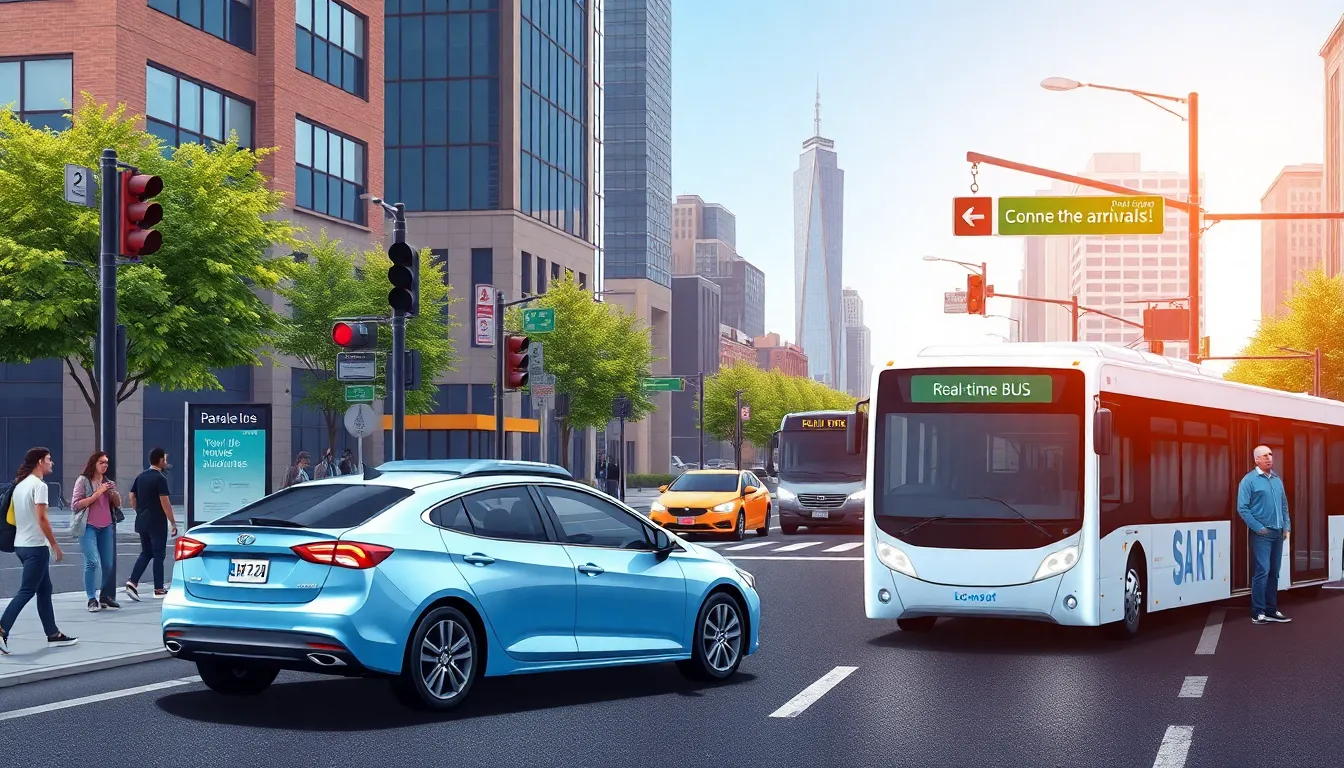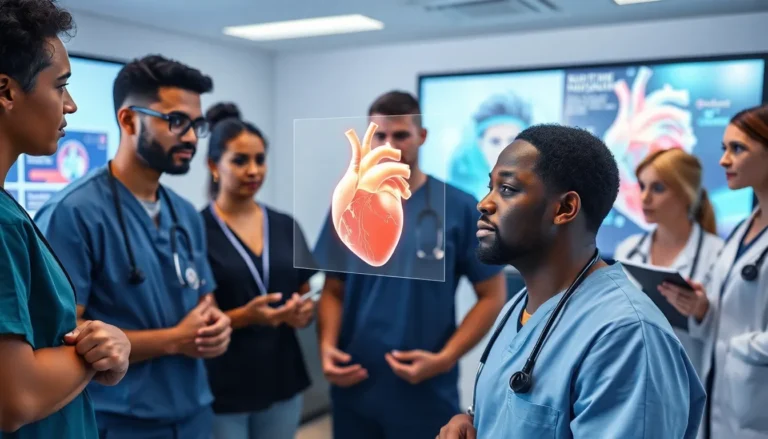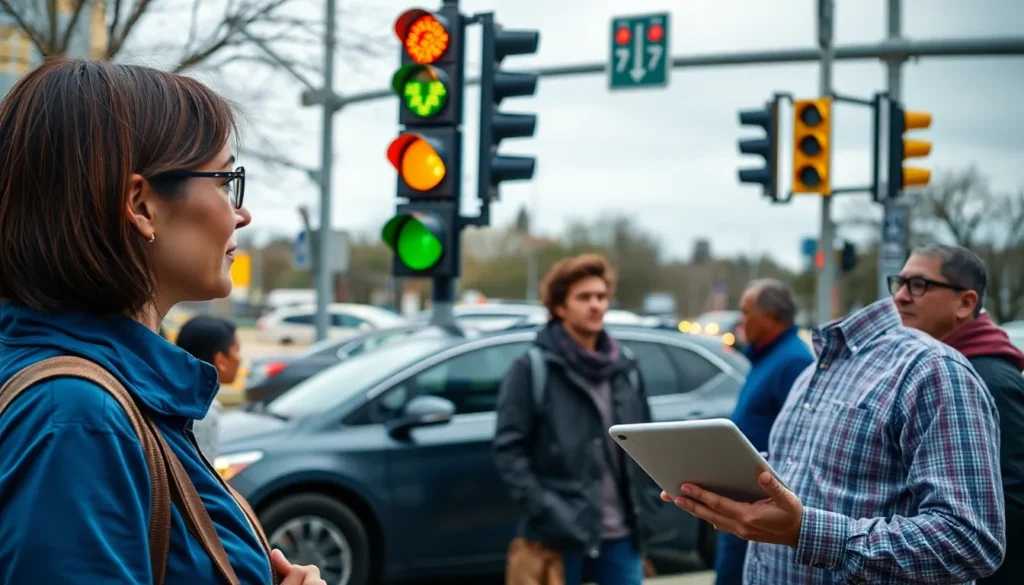Table of Contents
ToggleImagine a world where your car knows when you’re running late and adjusts its route to save you from that awkward conversation with your boss. That’s not sci-fi; it’s the magic of the Internet of Things (IoT) in transportation. This game-changing technology is revolutionizing how people and goods move, making travel smarter, safer, and a whole lot more efficient.
From smart traffic lights that reduce congestion to connected vehicles that communicate with each other, IoT is reshaping the transportation landscape. It’s not just about getting from point A to point B anymore; it’s about the journey becoming more enjoyable and less of a headache. Buckle up as we explore how IoT is driving the future of transportation, turning everyday commutes into seamless experiences.
Overview of IoT in Transportation
IoT significantly shapes transportation by enabling real-time data sharing among devices. Connected vehicles communicate with each other, traffic management systems, and infrastructure. Smart traffic lights adjust based on current traffic flow, reducing congestion and improving safety.
Enhanced vehicle tracking is another crucial aspect of IoT. Fleet managers utilize GPS and sensors to monitor vehicle locations and performance. This technology allows for efficient route planning and timely maintenance, reducing operational costs.
Safety measures benefit from IoT integration as well. Sensors in vehicles detect potential hazards, alerting drivers to take preventive action. Advanced driver assistance systems offer features such as lane-keeping and adaptive cruise control, which contribute to road safety.
Passenger experiences are also enriched through IoT. In public transportation systems, real-time tracking apps provide updates on bus or train arrivals, allowing users to plan their journeys effectively. This accessibility encourages more individuals to choose public transport over private vehicles.
Data analytics plays a vital role in optimizing transportation networks. By analyzing historical data, transportation authorities can identify patterns and predict future traffic scenarios. Such insights lead to better infrastructure investments and enhanced commuter safety.
The network of interconnected devices facilitates seamless communication, improving the overall transportation ecosystem. With continuous advancements, IoT continues to redefine how people and goods move efficiently and safely. Technologies like smart parking solutions further reduce the time and frustration often associated with finding parking spaces.
Overall, IoT transforms transportation beyond simple logistics, aiming to create a smarter, more connected journey for all users.
Benefits of IoT in Transportation

The integration of IoT technology in transportation delivers significant benefits, enhancing both safety and efficiency.
Enhanced Safety
IoT enhances safety through advanced sensors embedded in vehicles. Sensors detect potential hazards, such as obstacles or sudden stops, alerting drivers in real time. Connected systems also allow vehicles to communicate with one another, reducing the risk of collisions. Additionally, advanced driver assistance systems, like lane-keeping assistance, utilize IoT data to prevent accidents and support safe driving. Data from road infrastructure, such as smart traffic lights, contributes to safer environments by optimizing traffic flow and responding instantly to changing conditions. Fleet management systems equipped with IoT technology enable proactive vehicle maintenance, lowering the chances of breakdowns.
Improved Efficiency
Efficiency improves significantly with IoT solutions in transportation. Real-time data sharing among connected vehicles and traffic systems reduces congestion, allowing for smoother commutes. Smart traffic lights adapt to current traffic conditions, minimizing delays and optimizing routes. Fleet managers benefit from GPS tracking, enabling precise route planning and timely deliveries which reduce fuel consumption. IoT analytics provide insights into traffic patterns, facilitating better infrastructure investments that enhance overall efficiency. Public transportation systems leverage IoT to offer real-time tracking apps, boosting ridership by making travel more predictable and convenient. This interconnectedness results in timely travel experiences, promoting sustainability and reducing operational costs.
Key Technologies Driving IoT in Transportation
Sensors and data analytics play a crucial role in IoT applications within transportation. Advanced sensors collect vast amounts of data from vehicles and their surroundings. This data enables detailed analysis, identifying patterns related to traffic flow and vehicle performance. Analytics tools transform raw data into actionable insights, aiding in better decision-making for fleet management and traffic control. Predictive analytics warn of potential mechanical issues, minimizing unexpected breakdowns.
Cloud computing enhances the processing and storage capabilities for IoT applications. It allows for centralized management of large datasets collected from vehicles and infrastructures. Scalability is one of the key benefits, facilitating real-time data access from anywhere. Cloud platforms enable seamless communication between vehicles and traffic management systems. This integration supports the development of smart transportation solutions, reducing congestion and improving efficiency. By relying on cloud infrastructure, transportation systems can adapt to changing demands, ensuring optimal operation.
Real-World Applications of IoT in Transportation
IoT technology plays a significant role in transforming transportation through various real-world applications. These innovations improve efficiency, safety, and user experience across multiple sectors.
Smart Fleet Management
Smart fleet management systems leverage IoT to oversee and optimize vehicle operations. GPS tracking provides real-time location updates, allowing fleet managers to monitor routes and schedules effectively. Sensors equipped on vehicles track performance metrics, alerting managers to potential maintenance issues or safety concerns. Data analytics enhance decision-making by offering insights into fuel consumption and driver behavior. Cost savings become evident as fleets reduce downtime, optimize routes, and improve overall asset utilization.
Connected Vehicles
Connected vehicles integrate IoT technology for enhanced communication with other vehicles and infrastructure. Vehicles exchange data regarding traffic conditions, road hazards, and weather updates. This communication enables drivers to make more informed decisions while on the road. Advanced safety features, such as automatic braking and collision warnings, reduce accident risks. Furthermore, connected vehicles contribute to smoother traffic flow as they can respond dynamically to real-time conditions, decreasing congestion and promoting a more enjoyable driving experience.
Challenges and Considerations
The integration of IoT in transportation presents several challenges that demand careful consideration.
Data Security and Privacy
Data security stands as a major concern in the deployment of IoT technologies. Sensitive information shared among vehicles and infrastructure increases the risk of cyberattacks. The potential for unauthorized access to personal data is troubling for users. Implementing robust encryption standards and secure authentication processes can mitigate risks. Regulatory compliance also plays a crucial role in ensuring data privacy. Organizations must adhere to guidelines like GDPR to safeguard personal information. Addressing these security challenges fosters trust and encourages wider adoption of smart transportation solutions.
Infrastructure Limitations
Infrastructure limitations hinder the full potential of IoT in transportation. Many regions lack the necessary connectivity to support real-time data sharing. Outdated traffic systems do not effectively integrate with new technologies, creating inefficiencies. Upgrading existing infrastructure requires significant investment and planning. Cities must prioritize funding for smart traffic lights and communication networks. Additionally, collaboration between public and private sectors can accelerate development. Investing in modern infrastructure enhances the effectiveness of IoT applications and improves transportation systems overall.
The integration of IoT in transportation is reshaping how people travel and interact with their environment. By enhancing safety efficiency and user experience it’s paving the way for smarter commuting solutions. Real-time data sharing and advanced technologies are not just improving traffic management but also fostering a more sustainable future.
As the industry navigates challenges like data security and infrastructure limitations the potential for innovation remains vast. Embracing IoT will likely lead to a more connected and efficient transportation ecosystem. This evolution promises to benefit both individuals and communities making every journey safer and more enjoyable.







